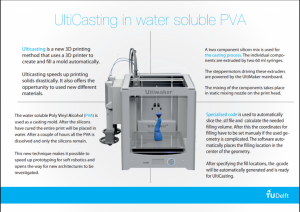A team of students at Delft University of Technology have successfully modified an Ultimaker 2 machine in order to cast silicone inside a 3D printed mold. The technique was unveiled by the students at the dutch university’s Science Fair. They’ve coined the technique ‘Ulticast’ and it has positive ramifications for the soft robotics industry. The concept involves creating a mold and 3D printing inside it simultaneously. The casting mold is created using water soluble Poly Vinyl Alcohol (PVA) requiring the final 3D printed form to be submerged in water following its print in order to remove the cast.
The time lapse featured above shows the successful printing of a thumb using Ulticast.
The introduction of a mold increases stability and allows the form of a 3D print to take new shape. The Ulticast process allows the silicone to set within the confines of a molded structure. This is important to the soft robotics field because it enables the 3D printing of soft actuators which, until now, have been difficult to produce. To read more about soft robotics, check out the Octobot.

This development is particularly impressive when considering the price in which the team were able to develop the technique. The setup came to the small price of $3,000. The team have also been working on a 3D printed glove which has soft actuators in order to move with one’s hand. However, they are aiming to delve further into this area following their prototype. It seems their main goal was always focused upon creating the 3D printing machine that made the glove possible. The team behind the project are hoping this concept will help push further developments of 3D printing in soft robotics.
Featured Image shows the team behind Ulticast. Image via their Soft Robotics blog.



